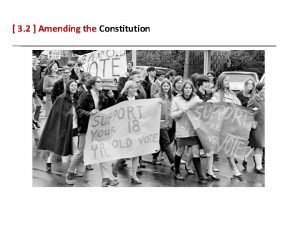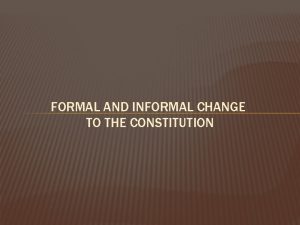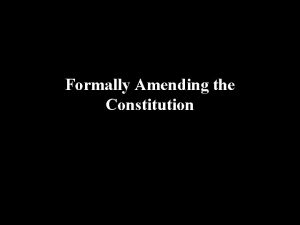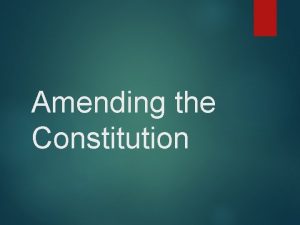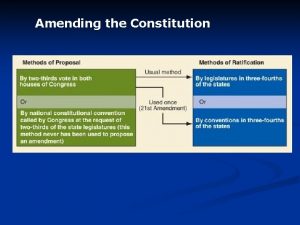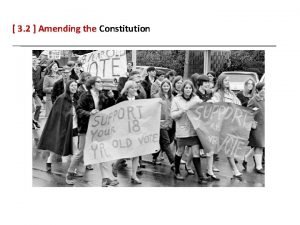Amending The Constitution We the People Changing the





- Slides: 5

Amending The Constitution We the People

Changing the Constitution • There were two paths of amending the Constitution: – The informal or “unwritten Constitution” • Based on tradition • The Presidential Cabinet-Established by tradition of Washington’s Cabinetadvisors • Judicial Review-Established by the Marbury vs. Madison (1803) Review • Congressional Committee System-Congress established this Systemprocess to passing legislation • Political Parties-Arose from the ratification process of the Parties. Constitution (Federalist vs Anti-Federalist) • 2 terms for presidents-Established by tradition of Washington presidentsserving only 2 terms. Formalized by the 22 nd Amendment in response to FDR being elected to 4 terms – The formal method of passing an amendment • Done 27 times since 1788

CONSTITUTIONAL AMENDMENTS The Bill of Rights • Main purpose: – To address the concerns of the Anti-Federalists and protect people’s rights • The Amendments: 1 st 2 nd 3 rd 4 th 5 th 1791 1791 6 th 1791 7 th 1791 8 th 1791 9 th 10 th 1791 Rights to Religion, Speech, Press, Assembly, Petition Right to Bear Arms Quartering of Soldiers Search and Seizure Grand Jury, Double Jeopardy, Self-Incrimination, Due Process Rights of Accused in Criminal Prosecutions: Rights to Jury Trial, to Confront Opposing Witnesses and to Counsel Jury Trial Protections against Excessive Bail, Cruel and Unusual Punishment Non-Enumerated (Listed) Rights are still Protected Rights Reserved to States

CONSTITUTIONAL AMENDMENTS • The Amendments: 11 th 12 th 13 th 14 th 15 th 16 th 17 th 18 th 19 th 20 th 21 st 22 nd 23 rd 24 th 25 th 26 th 27 th 1795 Suits Against a State 1804 Election of President and Vice-President 1865 Abolition of Slavery and Involuntary Servitude Protects rights against state infringements, defines citizenship, prohibits states from interfering with privileges and immunities, 1868 requires due process and equal protection, punishes states for denying vote, and disqualifies Confederate officials and debts 1870 Voting Rights for Former Slaves 1913 Federal Income Tax 1913 Popular Election of Senators 1919 Prohibition of Manufacture and Sale of Alcohol 1920 Women's Right to Vote 1933 Commencement of Presidential Term and Succession 1933 Repeal of 18 th Amendment (Prohibition) 1951 Two-Term Limitation on President 1961 District of Columbia Residents Gain Presidential Vote 1964 Abolition of Poll Tax Requirement in Federal Elections 1967 Presidential Succession due to Vacancy, Disability and Inability 1971 18 -year-olds Gain Right to Vote 1992 Sets Procedure for Congressional Pay Raises

Ratification • Ratification of the Constitution took 2 ½ years to complete. States in order of ratification are: 1. Delaware 2. Pennsylvania 3. New Jersey 4. Georgia 5. Connecticut 6. Massachusetts 7. Maryland 8. South Carolina 9. New Hampshire 10. Virginia 11. New York 12. North Carolina 13. Rhode Island (December 7, 1787) unanimous (December 12, 1787) 46 to 23 (December 18, 1787) unanimous (January 2, 1788) unanimous (January 9, 1788) 128 -40 (February 6, 1788) 187 -168 (April 24, 1788) 63 -11 (May 23, 1788) 149 -73 (June 21, 1788) 57 -47 (June 25, 1788) 89 -79 (July 26, 1788) 30 -27 (November 21, 1789) 194 -77 (May 29, 1790) 34 -32
